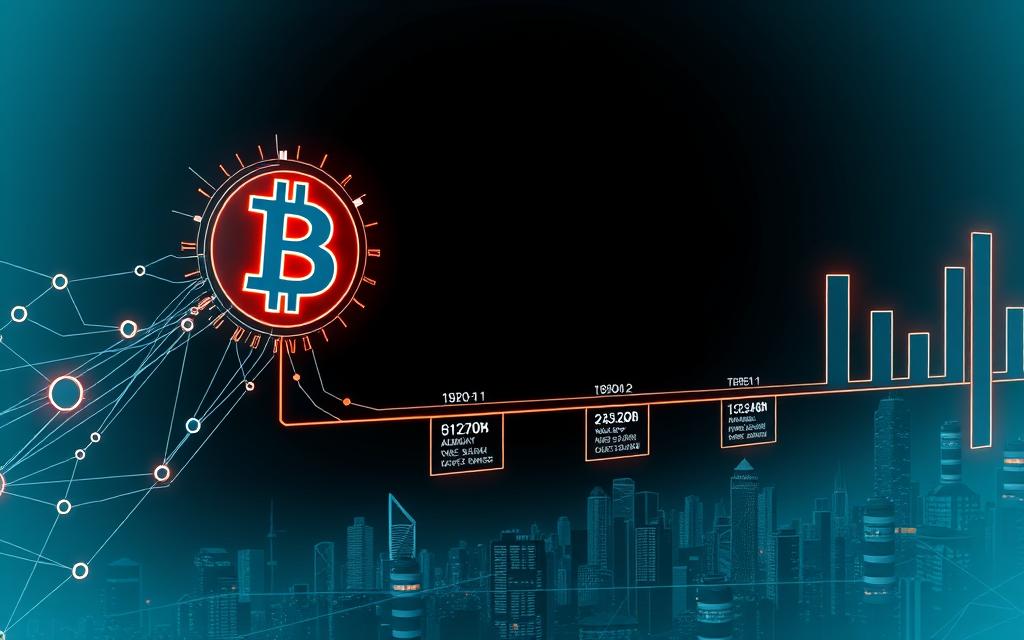Table of Contents
The average confirmation time for a Bitcoin transaction is about 10 minutes. However, transaction times can vary significantly due to factors such as network congestion, transaction fees, and the complexity of the transaction.
Unlike traditional bank transfers, which often appear instant, Bitcoin transactions follow a different verification process on the blockchain. When the network is congested, there is a backlog of transactions in the mempool, resulting in users paying higher transaction fees to expedite processing.
This article aims to help readers understand Bitcoin transaction times and optimize their transaction experience by explaining the confirmation process, factors affecting transaction speed, and methods to accelerate transactions.
Understanding Bitcoin Transactions
Understanding how Bitcoin transactions work is crucial for anyone looking to use the cryptocurrency effectively. A Bitcoin transaction is a transfer of value between Bitcoin wallets that gets recorded on the blockchain, a public ledger that contains the history of all Bitcoin transactions.
What Happens When You Send Bitcoin
When you send Bitcoin, you’re creating a transaction that consists of inputs, outputs, amount, and transaction fee. The inputs represent the source of the coins, while the outputs specify the destination address and amount. After initiation, the transaction is broadcast to the network for validation.
The transaction is then added to the mempool, where miners select transactions to include in blocks, prioritizing those with higher fees. As “the blockchain is a decentralized, distributed ledger that records transactions across many computers so that the record cannot be altered retroactively without the alteration of all subsequent blocks”, it ensures the security and integrity of the transaction.
The Role of the Blockchain in Transaction Processing
The blockchain plays a crucial role in processing Bitcoin transactions by providing a public ledger that records all confirmed transactions. It ensures the security and integrity of the transactions through cryptographic verification, preventing double-spending and ensuring that the recipient can access the funds once a transaction is confirmed.
The use of public and private keys is essential in the transaction process, as they enable secure and authorized access to the funds. By understanding how the blockchain works, users can appreciate the complexity and security of Bitcoin transactions.
How Long Does Bitcoin Take to Send: Average Times
The average time for Bitcoin transactions to be confirmed is a key consideration for users and investors alike. Understanding this timeframe is essential for navigating the Bitcoin network efficiently.
Standard Transaction Times
The average time it takes for a Bitcoin transaction to receive its first confirmation is approximately 10 minutes. This duration is based on the time it takes to mine a new block on the Bitcoin blockchain. However, it’s crucial to note that actual confirmation times can vary significantly due to network conditions.
- Average confirmation time: 10 minutes
- Variability based on network congestion: Transactions can be confirmed in as little as a few minutes or take several hours during peak times
- Difference between broadcast and confirmation: A transaction being broadcast to the network is not the same as it being confirmed
During periods of high congestion, transaction times can range from a few minutes to several hours. This variability highlights the importance of understanding the distinction between a transaction being broadcast to the network and actually being confirmed on the blockchain.
What Counts as a “Confirmed” Transaction
In Bitcoin, a transaction is considered confirmed when it is included in a block on the blockchain. The security of a transaction increases with the number of confirmations it receives. The industry standard is to wait for 6 confirmations, which takes approximately 1 hour, for large-value transactions to be considered fully secure.
Different exchanges and services have varying confirmation requirements. Some may accept transactions with fewer confirmations for smaller amounts, while others may require more. Users can track their transaction status using block explorers, providing transparency into the confirmation process.

The Bitcoin Confirmation Process Explained
Bitcoin transactions rely on a confirmation process to ensure their legitimacy and prevent double-spending. This process is fundamental to the security and trustworthiness of the Bitcoin network.
What Is a Bitcoin Confirmation?
A Bitcoin confirmation is a measure of how deeply a transaction is buried in the blockchain. Essentially, it is the number of new blocks added to the blockchain after the block containing your transaction. Each confirmation significantly reduces the risk of transaction reversal, thereby increasing the security of the transaction.
Why Multiple Confirmations Are Required
Multiple confirmations are required because they provide mathematical security against transaction reversal attempts. The first confirmation is the most crucial, as it signifies that the transaction has been included in a block. Subsequent confirmations add exponential security, making it increasingly difficult for an attacker to reverse the transaction.
The risk of double-spending is mitigated by multiple confirmations. High-value transactions typically require more confirmations than smaller ones due to their higher risk profile.
Confirmation Requirements by Major Exchanges
Different cryptocurrency exchanges have varying policies regarding the number of confirmations required. For instance, Binance requires 1 block confirmation for BTC deposits, while it demands 2 block confirmations for Bitcoin withdrawals. On the other hand, Coinbase requires 3 block confirmations before considering a BTC transaction final. This variation highlights the different security standards across platforms.
Users can check the number of confirmations their transaction has received by looking up the transaction ID on a blockchain explorer. The confirmation count directly correlates with transaction finality, and while waiting for confirmations, funds may appear as “pending” in the recipient’s wallet.
Factors Affecting Bitcoin Transaction Speed
The speed at which Bitcoin transactions are processed depends on several key factors. Understanding these factors is crucial for users who want to ensure their transactions are confirmed in a timely manner.
Network Congestion and Mempool Size
Network congestion is a significant factor affecting Bitcoin transaction speed. The Bitcoin network has a limited capacity, processing approximately 7 transactions per second. When the network is congested, transactions are delayed. The mempool acts as a waiting room for unconfirmed transactions. As network activity fluctuates, so does the mempool size. Users can monitor current congestion levels to anticipate delays. High network activity leads to increased transaction times.

Transaction Fees and Miner Prioritization
Transaction fees play a crucial role in determining the priority of transactions. Miners prioritize transactions based on the fees they receive. Paying a higher fee increases the likelihood of a transaction being processed quickly. During periods of high congestion, a fee market emerges as miners select transactions with higher fees first. Historical examples have shown dramatic spikes in fees during extreme congestion periods.
Transaction Size and Complexity
The size and complexity of a transaction also impact its processing time. Larger transactions with multiple inputs or outputs require more processing resources, leading to longer confirmation times. Simplifying transactions can help reduce processing times. Additionally, the time of day and day of the week can influence network congestion, further affecting transaction times.
The scalability limitations of the Bitcoin blockchain contribute to variable transaction times. As the network continues to evolve, understanding these factors will help users navigate the complexities of Bitcoin transactions.
The Bitcoin Mempool: Your Transaction’s Waiting Room
The mempool is a critical component of the Bitcoin network, acting as a buffer for transactions that have been broadcast but not yet validated. It serves as a temporary storage area where unconfirmed transactions wait to be picked up by miners and included in the next block on the blockchain.
How the Mempool Works
Each node on the Bitcoin network maintains its own version of the mempool, storing transactions that have been verified as valid but not yet confirmed. When a new transaction is broadcast, it is added to the mempool of each node that receives it. Miners select transactions from their mempool to include in new blocks, prioritizing those with higher transaction fees.
- Transactions enter the mempool after being broadcast and validated by nodes.
- The mempool size fluctuates based on network activity and the rate of block creation.
- Transactions with insufficient fees may remain in the mempool for extended periods.
Monitoring Mempool Congestion
Users can monitor current mempool conditions using various tools and resources. Mempool visualization tools help estimate appropriate transaction fees by showing the current level of congestion. The size of the mempool directly correlates with required transaction fees; higher congestion means higher fees are needed for timely confirmation.

As new blocks are added to the blockchain, the mempool is periodically cleared of confirmed transactions, reducing its size until more unconfirmed transactions accumulate.
How to Speed Up Your Bitcoin Transactions
To expedite your Bitcoin transactions, understanding the factors that influence their speed is crucial. Bitcoin transactions are processed in a queue, and their speed depends on several factors, including network congestion, transaction fees, and the size of the transaction.
Setting Appropriate Transaction Fees
One of the most effective ways to speed up your Bitcoin transaction is by setting an appropriate transaction fee. The fee you pay to miners directly impacts how quickly your transaction is processed. Using a bitcoin transaction fee calculator can help you determine the optimal fee based on current network conditions.
For urgent transactions, a higher fee is recommended to prioritize your transaction over others. Conversely, for non-urgent transactions, you can opt for a lower fee, but be prepared for a longer processing time.
Timing Your Transactions During Off-Peak Hours
Another strategy to accelerate your Bitcoin transactions is to send them during off-peak hours when the network is less congested. Monitoring the mempool size chart on blockchain.com explorer can help you identify periods of low congestion, allowing you to schedule your transactions accordingly.
Replace-By-Fee (RBF) and Other Acceleration Methods
For transactions that are taking too long to process, you can utilize the Replace-By-Fee (RBF) protocol. RBF allows you to increase the fee of a pending transaction, making it more attractive to miners. Additionally, methods like Child-Pays-For-Parent (CPFP) enable you to accelerate a stuck transaction by spending its unconfirmed output with a higher fee.
Some mining pools also offer transaction accelerator services, which can further expedite your transaction. Understanding these options and how to implement them in popular wallets can significantly enhance your Bitcoin transaction experience.
Alternative Solutions for Faster Bitcoin Transfers
Bitcoin’s scalability issues have led to the exploration of alternative solutions for faster transfers. As the network grows, the need for speedy transactions has become more pressing, prompting the development of innovative solutions.
The Lightning Network: A Second-Layer Solution
The Lightning Network is a significant development aimed at enhancing Bitcoin’s transaction capacity. By creating a second layer on top of the Bitcoin blockchain, it enables near-instant transactions with minimal fees. This is achieved through payment channels that allow for multiple transactions without the need for constant interaction with the main blockchain.
The current state of Lightning Network adoption is growing, with various wallets and services integrating this technology. However, it still faces limitations, including the need for widespread adoption to maximize its potential.
Using Alternative Cryptocurrencies for Faster Transfers
Another approach to achieving faster transaction times is to use alternative cryptocurrencies known for their speed. Cryptocurrencies like Litecoin and Ethereum offer faster confirmation times compared to Bitcoin, making them suitable for transfers where speed is a priority.
Exchanging Bitcoin for these alternative cryptocurrencies on exchanges is a straightforward process, allowing users to leverage their faster transaction capabilities. However, this approach involves considering the trade-offs between using Bitcoin and alternative cryptocurrencies, including differences in security, adoption, and market volatility.
For more information on Bitcoin’s scalability, visit the Scalability FAQ on the Bitcoin Wiki.
Conclusion: Balancing Speed and Security in Bitcoin Transactions
Our examination of Bitcoin’s transaction processing times highlights the delicate balance between speed and security in the network. The standard confirmation time is approximately 10 minutes per confirmation, with 6 confirmations being the gold standard for security. Factors such as network congestion, transaction fees, and transaction size significantly influence transaction times. To optimize your Bitcoin experience, it’s essential to understand these dynamics and choose the right approach based on the urgency and value of your transaction. Higher fees generally result in faster confirmations, especially during periods of network congestion. By leveraging tools like block explorers and mempool monitoring, users can make informed decisions. As Bitcoin evolves, its transaction processing will likely become more efficient, empowering users to balance speed and security effectively.
FAQ
What is the average time for a Bitcoin transaction to be confirmed?
The average confirmation time for a Bitcoin transaction is around 10 minutes, which is the time it takes for a new block to be added to the blockchain. However, this time can vary depending on network congestion and the transaction fee paid.
How does the Lightning Network impact Bitcoin transaction times?
The Lightning Network is a second-layer scaling solution that enables faster and cheaper transactions by allowing users to make multiple transactions off-chain, which are then settled on the blockchain in a single transaction. This significantly reduces transaction times and fees.
What factors affect the speed of Bitcoin transactions?
The speed of Bitcoin transactions is affected by several factors, including network congestion, transaction fees, and the size and complexity of the transaction. Higher transaction fees can prioritize a transaction for confirmation, while larger and more complex transactions may require more time to process.
Can I speed up my Bitcoin transaction if it’s taking too long?
Yes, there are several ways to speed up a Bitcoin transaction, including setting a higher transaction fee, using the Replace-By-Fee (RBF) feature, or utilizing the Lightning Network. Timing transactions during off-peak hours can also help reduce congestion and speed up processing.
How many confirmations are required for a Bitcoin transaction to be considered secure?
The number of confirmations required for a Bitcoin transaction to be considered secure varies depending on the recipient’s requirements. Major exchanges typically require 3-6 confirmations, while some merchants may require more. Each confirmation represents an additional block added to the blockchain, making the transaction more secure.
What is the role of miners in the Bitcoin transaction process?
Miners play a crucial role in the Bitcoin transaction process by verifying and validating transactions, grouping them into blocks, and adding them to the blockchain. Miners are incentivized to prioritize transactions with higher fees, which helps to secure the network and process transactions efficiently.
How does the mempool impact Bitcoin transaction times?
The mempool is a waiting area for unconfirmed transactions, and its size can impact transaction times. When the mempool is congested, transactions may take longer to be confirmed, as miners prioritize transactions with higher fees. Monitoring mempool congestion can help users anticipate and plan for potential delays.









